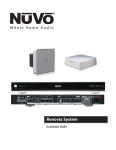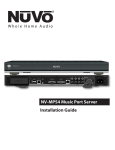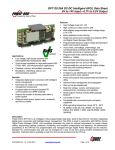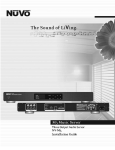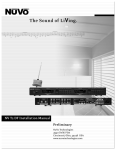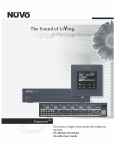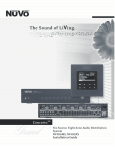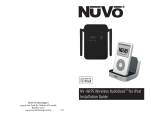Download Nuvo NV-MP Stereo System User Manual
Transcript
NV-MP Music Port Installation Guide FCC Radio Frequency Interference Statement Warning This equipment has been tested and found to comply with the limits for a Class B digital device, pursuant to Part 15 of the FCC Rules. These limits are designed to provide reasonable protection against harmful interference in a residential installation. This equipment generates, uses, and can radiate radio frequency energy and, if not installed and used in accordance with the instructions, it may cause harmful interference to radio communications. However, there is no guarantee that interference will not occur in a particular installation. If this equipment does cause harmful interference to radio or television reception, which can be determined by turning the equipment off and on, the user is encouraged to try to correct the interference by one or more of the following measures: - Reorient or relocate the receiving antenna. - Increase the separation between the equipment and receiver. - Connect the equipment into an outlet on a circuit different from that to which the receiver is connected. - Consult the dealer or an experienced radio/TV technician for assistance. This device complies with Part 15 of the FCC Rules. Operation is subject to the following two conditions: (1) This device may not cause harmful interference, and (2) this device must accept any interference received, including interference that may cause undesired operation. EN55022 Class-B EN55024 IC Statement This Class B digital apparatus complies with Canadian ICES-003. Introduction The Music Port is a unique collaboration between NuVo Technologies and Autonomic Controls. It is a compact package of hardware and software that enables home desktop and laptop PC's to act both as sources and controllers in a NuVo Grand Concerto or Essentia E6G or future NuVoNet capable multi-room audio systems. Music Port consists of the NV-MP, a small hardware device which can be installed on-wall, inrack, or otherwise hidden from view, and PC software. You can install Music Port as an upgrade to an existing system or as part of a brand new NuVo multi-room audio system. Music Port software is installed via a user-friendly interface, and works with Windows XP, Windows Vista and Windows Home Server, as well as most existing PC sound cards. Music Port delivers two primary functions. The first is to transform a host PC into a full-fledged multi-output source for a NuVo system. The second primary function of the Music Port is to enable any desktop PC, laptop PC, or portable tablet PC that is connected to the home network to serve as a controller for a NuVo distributed audio system, much like the NuVo OLED Control Pads already do. Through the Music Port Client, the user can browse their music library with full album art and control their home's music from anywhere in the home via hard-wired or wireless devices. Table of Contents I. Getting Started II. Hardware Installation III. Establishing Music Port in the I8G and E6G Confgurator Software IV. Installing the Media Control Server on the Host PC V. Configuring the Media Control Server on the Host PC VI. Advanced Server Configuration VII. Recommended Music Port Host PC Settings VIII. Transferring Files from Client PC to Host PC IX. Installing the Music Port Client X. Using the Music Port Client Interface XI. Music Port Control from the NuVo Control Pad Specifications Page 3 Page 3 Page 5 Page 6 Page 10 Page 17 Page 19 Page 23 Page 30 Page 33 Page 39 Page 42 I. Getting Started The Media Control Server (MCS) is designed to run on a computer that is equipped with Windows XP Home Service Pack 2 or Vista Service Pack 1. It should have 1 GB RAM and at least a 1 GHz x86 based processor. It is recommended that you dedicate a computer or server to get the best performance as a NuVoNet audio source. The PC that runs the MCS will be referred to as the host PC. The Music Port Client can then be installed on any of the home's networked PCs or touch screens for music control. The Music Port Client provides the ability to control audio playback in any zone in the home. II. Hardware Installation of the Music Port Making the Audio Connections (Fig. 1) PC sound cards typically use a stereo mini, 3.5mm audio jack. The Music Port allows access to stereo, 5.1 or 7.1 surround audio cards on the host PC as multiple independent stereo audio streams. Use a 3.5mm to RCA cable to connect the PC's audio outputs to the appropriate source inputs on theGrand Concerto or Essentia E6G. If you are going to use a 5.1 sound card, for example to convert the PC into a threeoutput music server, you will have to make three connections. You would connect the Front Left/Right (L/R) jack to one source input on the amplifier, Surround Left/Right (LS/RS) to a second input, and Center/Low Frequency Effects (C/LFE) to a third input. Consult the documentation for your particular sound card to determine which audio jack corresponds to which pair of channels. Once the connections are made, make note of which sound card output is connected to which amplifier source input, as this information will be needed when configuring the Media Control Server. 3 Figure 1- Audio Connections VARIABLE OUTPUT TIP=L RING=R VARIABLE OUTPUT SPEAKER 40W/6 OHMS X 2 LEFT RIGHT TIP=L RING=R FIXED OUTPUT ZONE 1 1 2 VARIABLE OUTPUT SPEAKER 40W/6 OHMS X 2 LEFT RIGHT TIP=L RING=R ZONE 2 3 4 TIP=L RING=R FIXED OUTPUT ZONE 3 ZONE 4 1 6 5 VARIABLE OUTPUT SPEAKER 40W/6 OHMS X 2 LEFT RIGHT FIXED OUTPUT FIXED OUTPUT 2 3 5 6 CONNECT TO NV-I8X L L R 1 L R 2 3 USE NV-SLC1 CABLE R 4 5 4 6 SOURCE LINK SOURCE INPUTS SOURCE STATUS Making the Connections to the Music Port Hardware (Fig. 2) To install the Music Port hardware, connect the DB9 serial port output on the host PC (this may require the installation of a serial card in the host) using a standard nine pin serial cable. This connection is made at the side of the Music Port box labeled Controller. Connect a standard network CAT5 cable from the NuVoNet RJ-45 port on the Music Port hardware to one of the Device connections on either the Essentia E6G Allport or the Grand Concerto EZ Port. When connected, the blue Power LED will light. A second “RS232” DB9 port allows the Music Port Client to access specific Zone and Source control through NuVoNet. When this serial cable is connected, “Zone” and “Source” buttons will appear at the top of the PC Interface application. From those buttons, any zone or source can be accessed and controlled. This second serial cable is only required if the Music Port Client is going to be used, see section X. Using the Music Port Client Interface, pg. 33. 4 Figure 2: –Music Port Hardware Connections SIR SR 86 (P101) Sirius Pops 3:09 PM Jozef Kossovit Hungaria MENU OK POWER NuVoNet Address VARIABLE OUTPUT TIP=L RING=R RS-232 FIXED OUTPUT 1 2 3 4 5 NuVoNet Source Address 6 ZONE 7&8 USE CNLY WITH 250V FUSE PROGRAM SYS ON CONNECT TO NV-I8EZP1 CONNECT TO NV-I8X USE NV-NC1 CABLE USE NV-SLC1 CABLE NETWORK DIGITAL LINK MODEL NV-I8DM SIX SOURCE EIGHT ZONE AUDIO DISTRIBUTION SYSTEM 120V 60Hz 500W FUSE:T5 A NuVo Technologies Cincinnati Ohio USA www.nuvotechnologies.com EXT. MUTE R CONFORMS TO UL STD.6500 CERTIFIED TO CAN/CSA STD.E60065 US C SYSTEM 3033118 III. Establishing Music Port in the I8G and E6G Configurator Software (Fig. 3) The I8G and E6G Configurator Software is an optional setup tool for establishing sources and zone control of the Grand Concerto and Essentia E6G Audio Distribution Systems. The Source tab within the software allows each of the six available source inputs to be established. To establish desired inputs within the I8G and E6G Configurator, within the “Source” tab of the Configurator, double click on an available source input 1-6. This will open a “Source Select” window. There, you can establish a name for the Music Port sources within the “Display Name” window (Note that unless you check the box “Always Use Display Name (ignore name sent by NuVoNet Device)”, the Music Port will automatically place a name in the Source menu. Create a three-character abbreviation for each of the Music Port sources in the “Short Name” window. Scroll to NuVo as a manufacturer and select NV-MP and double click. Repeat these steps for each of the Music Port sources being established. 5 Figure 3 – Establishing Music Port in the I8G and E6G Congifurator Software IV. Installing the Media Control Server on the Host PC Installing the Media Control Server (Fig. 4) To begin, insert the included CD and make sure you have an Internet connection. The Media Control Server installation wizard will allow you to register and install the Music Port Configuration tool on the host computer. It will also check for software upgrades. Click on the Next button to proceed to registration. Registering Media Control Server (Fig. 5) To register your product, simply complete the Name, Organization, and Email Address fields in the Customer Registration window. Click next to continue. Activating Media Control Server (Fig. 6) Your Music Port Package has an important 26-character License Key printed on the install CD case. Once the License Key fields are completed in the Activation window, the installation application will verify the activation key via the Internet and complete the installation. 6 Figure 4 – Installing the Media Control Server Figure 5 – Registering the Media Control Server 7 Figure 6 – Activating Media Control Server Setup (Fig. 7) The installer wizard will automatically install two applications. The Media Control Server (MCS) provides access to the music library on the PC and manages its audio outputs. The NuVo Bridge is used to make the MCS accessible to the NuVo distributed audio system. The installer has the ability to disable one or both of the applications. Most installations require that both applications are installed. To complete the installation in its default format, click the Next button. Completing the Media Control Server Installation (Fig. 8) To complete the installation, click on the Next button. The wizard will finish the installation and prompt you to restart the computer when it is complete. 8 Figure 7 – Setup Figure 8 – Completing the Media Control Server Installation 9 V. Configuring the Media Control Server on the Host PC Once the Media Control Server (MCS) is installed, it can be accessed by going to Start>All Programs->Autonomic Controls->Media Control Server->MCS Configuration. Control Server Tab (Fig. 9) The Control Server tab displays the status of the MCS. The Media Control Server status in the upper right hand side of the tab should indicate that the MCS is running. It is rare that any changes will have to be made to the settings in this tab. If changes are necessary, see section VI. Advanced Server Configuration, pg. 17. Figure 9 – Control Server Tab 10 Media Sources Tab (Fig. 10) Media Sources define the music files available to the user and the configuration of the audio outputs from the host PC. Windows Media Player is the resident music archiving software and is included with XP, Vista, or Window's XP Media Center operating systems. That will appear by default under the Select Media Source header. If you have downloaded iTunes, it will appear as well. If you intend to use more than 1 audio output from the PC, make sure that “Split in Multiple Channels?” is set at “True”. This will convert the audio output configuration from surround to multiple stereo streams. Figure 10 – Media Sources 11 Configure Playback Devices (Fig. 11) The Configure Playback Devices button at the bottom of the Media Sources tab will open an Audio Devices Properties window. The actual appearance of this window will vary depending on the manufacturer of the PC sound card being used. The “Advanced Speaker Settings” window will let you establish the type of card within a drop-down menu. This is an important step. The output choice you make needs to match the number of sources you intend to setup for NuVoNet. For example, if you have a 5.1 surround card in the host PC, but you intend on using only two of the three available outputs, you should select quadraphonic within Advanced Speaker Settings. This will establish two independent stereo audio streams for NuVoNet. If you intend on using all three of the available audio outputs on the 5.1 surround card, select 5.1 within the “Advanced Speaker Settings”. A 7.1 surround card would represent four stereo audio streams for the NuVo System. Once you have selected the appropriate number of outputs, return to the “Media Sources” tab. When this is complete, two new columns will appear, Channels and the number of channels discovered. For example, if you are configuring a 5.1 surround card, you will see (three found). Each channel listed in this column can be given a specific name, (i.e. PC Music A or PC A), to match the appropriate output, Fig. 12. The names entered here will appear as the source names within the Sources menu on the NuVoNet Control Pads. Note that many surround audio cards require an audio cable to be plugged into at least one output before any information appears in the “Media Sources” tab. It is recommended that you plug in your audio cables from the host PC to the NuVo system prior to configuring the MCS, see section II, “Making the Audio Connections”, pg. 3. 12 Figure 11 – Configure Playback Devices Figure 12 – Renamed Sources 13 NuVo Bridge Tab (Fig. 13) The sources defined in the previous “Media Sources” tab are now selectable with the NuVo Bridge. At the top of the tab is a “Serial Connection” drop-down that defaults to “Automatic”. This drop-down is used to select which of the PC's COM ports is to be used for communication with the Music Port Hardware. If necessary, the drop-down menu provides a means for manually selecting a COM Port or you can click on the Discover button and allow the MCS to search for a connected Music Port. “Audio Connections” shows six drop-down boxes. These correspond with the six source inputs on either the Grand Concerto or Essentia E6G systems. Each input has a dropdown menu that contains the outputs established in the previous “Media Sources” tab. This tab is used to inform the MCS how the audio cables are connected between the PC and the NuVo System. Next to each NuVo input, select which PC output it is connected to. Only select a source for the inputs Music Port will occupy within the NuVo System. Leave the others with the default value of “Please configure your NuVo inputs”. Once these selections are made, Music Port is ready for NuVoNet communication. Click the Save button at the bottom of the tab. Registration (Fig. 14) The Registration tab indicates that the installed MCS is valid. This is established at the initial installation of the configuration tool. The license is intended for a single host PC that acts as the music source for the NuVo audio system. Within the Registration tab you can transfer the license to a different computer if necessary. 14 Figure 13 – NuVo Bridge Figure 14 – Registration 15 NuVoNet Communication (Fig. 15) When NuVoNet communication has been established, the NuVo Control Pads will display the menu search capability. Scrolling through the music menu is done with the up and down arrows. The OK button selects the highlighted choice. All of the artist, album and genre information is supplied by NuVoNet and is automatically displayed on the Control Pads. Figure 15 – NuVoNet Communication Main Menu Favorites Sources Playlists Artist Album Genre Track MENU OK 16 VI. Advanced Server Configuration The MCS Configuration utility allows you to adjust advanced settings associated with the control protocol and the host PC. You should only make changes to these settings if you are familiar with all the concepts in the section, or you have been instructed by Autonomic Controls support. Making incorrect changes in this utility can cause the host PC or the Music Port Client to stop working. From the start menu select All Programs and select Autonomic Controls, Media Control Server/MCS Configuration. On the Control Server tab you will observe several settings. Network Control This setting establishes the port number on which Music Port Client will communicate with the host PC. This should only be changed if you have a known conflict and have been instructed to do so by Autonomic Controls support. If the Music Port Client will be accessing the host PC through a hardware firewall (through the internet), then you must configure the firewall to forward requests on this port to the IP address of the host PC. The installation utility will open the default port (5004) on the Windows Firewall during installation. If you change this setting, you must manually reconfigure the Windows Firewall to allow communication on this port. Remember, the Windows Firewall is effective even when communicating within your LAN. Serial Control Serial control is used when you have licensed Autonomic Control's Integration Development Kit, and is documented in the MCS Control Protocol Documentation. Serial control is also used when a third party automation device is used to control the Grand Concerto or Essentia E6G. For more information on this see the white paper, “Using Third Party Automation Device with the Music Port” located on the NuVo Website Prozone. 17 Web Server Port This setting should only be changed if absolutely necessary. The installation utility will open the default port (5005) on the Windows Firewall during installation. If you change this setting, you must manually re-configure the Windows Firewall to allow communication on this port. Remember, the Windows Firewall is effective even when communicating within your LAN. Media Control Server Status The Media Control Server Status at the top right-hand corner of the Control Server tab tells you if the MCS is running and allows you to start or stop the service. If it is not running, clicking on the Start button to enable it. 18 VII. Recommended Music Port Host PC Settings Properly configuring the Host PC will greatly enhance the user’s experience with the Music Port. This section outlines the best recommended settings. Making the following settings on the Host PC will require a connected monitor, keyboard and mouse. Microsoft Windows AutoPlay Settings The Host PC can be easily setup to automatically rip audio CD’s to the host hard drive. This eliminates the need for a monitor and allows adding CD content to the Host PC with little effort on the part of the user. Vista Operating System (Fig. 16) To setup the Host PC to automatically rip CD’s within Vista, first click on the Start button and select Control Panel. Within Control Panel, select Hardware and Sound -> AutoPlay. When in AutoPlay, under the Audio CD section, Change the default to either “rip music from CD using Windows Media Player”, or “Import Songs using iTunes”. You need to decide whether you want the music content to default to Media Player or iTunes. Once Figure 17– Window Media Player Auto Play 19 XP Operating System (Fig. 17) Within XP, double click on the My Computer icon on the desktop. Right Click on the CD drive and select Properties. Within the Properties window, select the “AutoPlay” and select Music CD from the drop-down menu. Choose “rip music from CD using Windows Media Player”, or “Import Songs using iTunes”. Figure 17– Window Media Player Auto Play 20 Customizing Windows Medial Player and iTunes Within Media Player and iTunes, there are several file format and compression choices. Media Player’s default format is WMA (Windows Media Audio) and iTunes uses AAC (Advance Audio Coding). The problem with these formats is that neither will play in both software applications. This makes freely sharing files across multiple platforms impossible. The best format for sharing audio files is MP3 since it will play equally well within Media Player or iTunes. The following section provides instructions for setting MP3 as the default format and setting the compression rate for the best possible audio reproduction. Windows Media Player (Fig. 18) With Windows Media Player open, direct your cursor over the Rip tab and click on the down arrow. Select “More Options”. An “Options” window will appear. Select the Rip tab. Under “Format”, change the format from Windows Media Audio to MP3. Make sure that Rip CD when inserted is checked. Under that, select Always. Check Eject CD when ripping is complete. Under “Audio Quality”, the slider allows you to select the default file compression. Moving the slider to the right improves the audio quality. The higher the compression number, the larger the file will be. If disc space allows, set the compression at 320 Kbps for the best possible audio quality. Figure 18– Window Media Player Rip Music Tab 21 iTunes (Fig. 19) With iTunes open, select the “Edit” tab, then click on Preferences. In the new window that appears, select the “Advanced” tab and from that screen, the “Importing” tab (note that iTunes uses the term “Import” where Windows Media Player refers to this function as “Rip”). Within the “On CD Insert” drop-down menu, select “Import CD and Eject”. Below this is another drop-down menu, “Import Using”. Within that menu, select “MP3 Encoder”. In the “Setting” drop-down menu, select “Custom”. This will bring up a daughter window with a menu labeled, “Stereo Bit Rate”. Within that menu, select 320 Kbps and click on OK. At the bottom of the Importing tab there are four check boxes. Deselect “Play songs while importing or converting”. Select OK. Figure 19– iTunes AutoPlay 22 VIII. Transferring Files from Another Computer to the Host PC. The previous sections dealt with ripping audio CD content directly to the Host PC’s hard drive. Music can also be shared with the Host PC from other computer’s across the home’s network. We refer to these as Client PCs. Find the Host PC’s Name (Fig. 20) If you are using Vista, right click on the “My Computer” icon on the Host PC desktop and click Properties. The computer’s name will appear in the center of the new window. Note the name for future reference. If you are using XP, you must click on the Computer Name tab that appears in the “System Properties” window. Figure 20– Host PC Name 23 Set the Host PC for Automatic Login (Fig. 21) Click on the “Start” button and select Run. This will bring up a small window with a text box. Type “control userpasswords2” in the text box and click “OK”. Highlight the user name and deselect “Users must enter a user name and password to use this computer”. Once the password requirement is deselected, click OK. Removing the user name and password will make it much easier to share content from client computers. Figure 21– Host PC Auto Login 24 Setup the Music Folder for File Sharing in Vista (Fig. 22) Click on the Start button of the Host PC and right click on Music. Select Share. In the drop-down menu, select Everyone and then select Add. Under “Permissions Level” there is another drop-down menu. Select “Contributor”. If your file sharing is password protected, click the text labeled “Network and Sharing Center”. This will bring up a new screen with a drop-down menu, “Password Protected Sharing”. Within this menu, select “Turn off password protected sharing” and click Apply. This will return to the “File Sharing” window where you need to click on the Share button to complete the setup. Windows will confirm that the music folder is now being shared, and it will give you a link, (Fig. 23). Write down the name of this link, as you will need it to create short cuts on client computers. Figure 22– Vista File Sharing 25 Figure 23– Shared Link Setup the Music Folder for File Sharing in XP (Fig. 24) Click on the Start Button of the Host PC and right click on My Music. Select Sharing and Security. The “My Music Properties” window will appear. Within that, switch the selection to “Share this folder”. Click on the Permissions button. This will bring up a “Permissions for My Music” window, (Fig. 25). “Everyone” should be in the “Group or user names” window. Below that in a window titled “Permissions for Everyone” make sure that “Full Control” is allowed. Click Apply. Click OK in the “My Music Properties” window. 26 Figure 24– File Sharing in XP Figure 25– XP File Sharing Permissions 27 Creating a Music Link on a Remote Computer Once the Host PC is setup, creating a desktop link on the desktop of any client computer is an easy process. On the client computer, right click on any part of the desktop where there is not a shortcut. Choose New and select Shortcut. Type the shared link noted from the previous section into the text box, (Fig. 26). Click Next and give the shortcut a name. It will appear as an icon on that computer’s desktop. By double-clicking on the shortcut you will have access to the Host PC music files. This allows music content to be copied and pasted between the client PCs and the Host PC, (Fig. 26). Figure 26 – Creating a New Shortcut 28 Figure 27 – Shared Music 29 IX. Installing the Music Port Client An important feature of the Music Port is a computer application called the Music Port Client. This opens a control interface on any computer on the home's wired or wireless LAN. From the Client, the user has full browsing access to the host PC music library, as well as zone and source selection capability. On any client PC, click the Start button. If the PC is running Vista, click on Search and in the text box type \\ and the Host PC name from the initial Host setup, (Fig. 28). Figure 28 - Vista Search Window 30 If your PC is running XP, click on the start button and select Run. This will open a new window with a text box. Type \\ and the Host PC name from the initial Host setup, (Fig. 29). A new window will appear with the shared folders on the Host PC. Select the “Public” folder, and within that, select “Documents” and then select “NuVo”. Within the NuVo folder you will see a NuVo icon labeled “Music Port Client Setup”, (Fig. 29). Doubleclick on the Music Port Client Setup and follow the prompts. This will install the Client software on the Client PC. When the Music Port Client is installed, you will be prompted to open the software. When opened, the user has access to the NuVo System’s sources, zones, and full browsing capability within the Host PC music library, (Fig. 30). Figure 29 - XP Run Window 31 Figure 29 - Music Port Client Setup Figure 30 - Music Port Client interface 32 X. Using the Music Port Client Interface Access to the Music Port music library is available through the Music Port Client. Once installed on the Client PC, this beautiful interface makes the music on the Host PC available through the home’s network. Connecting to the Music Port (Fig. 31) When the Client is installed on a Client PC, the application is designed to recognize the Host PC through the home’s router connection. Open the Client either by going to Start and selecting Programs, then select NuVo, Music Port Client. When the Client is opened, a connection window will appear as communication is established. Once connected, the “Now Playing” window is the default. Manually Connecting to the Client Software (Fig. 32) If it is necessary, you can manually connect to the Client by clicking on the “Connect” button in the center of the connection window. This will open a window with a numeric touch pad and text box. You can type the Host PC name into the text box, see Find the Host PC Name, pg. 23, and clicking on the Enter button. You can also enter the IP address for the Host using the numeric keypad. Figure 31 - Connecting to the Music Port 33 Figure 32 - Manually Connecting to the Music Port Navigating the Music Library When the Client is opened, it will default to the “Now Playing” window, Fig. 33. This window features the album art (if availalbe) for the selected album along with the artist, album and track information. Clicking on the album art will open a list of the individual tracks. The currently selected track will be highlighted by a representation of an audio spectrum analyzer. Basic browsing is available through a series of buttons to the left of the current album art. Clicking on Albums, Artists, or Genres will take you to the music library, Fig. 34. Navigation through the library features the ability to quickly access the available music by alphabet. Clicking on a letter of the alphabet will move to selections starting with that letter. You can scroll across the alphabet by left clicking and pulling the curser across the letters. Each letter will expand as you scroll over it, Fig. 35. Releasing the left mouse button on a letter will move the library to that letter. Track forward and back, play/pause, shuffle, repeat, volume and mute transport control is available at the bottom of the Now Playing interface. 34 Figure 33 - Music Port Client Now Playing Window Figure 34 - Music Library Navigation 35 Figure 35 - Music Port Client Alphabet Search Managing the Queue The Music Port Client is based on a music queue system. When a listening choice is made it is automatically placed in a temporary playlist. You can view the current list by clicking on the Queue button to the left of the Client interface. If you want a selection to begin immediately playing, click and hold for approximately three seconds. Moving spectrum analyzer bars indicate the choice that is currently playing. Zones (Fig. 36) The “Zones” tab allows access to the NuVo System zones through the “RS232” port on the Music Port box and the DB9 input on the NuVo System. These correspond to the zone addresses assigned to each Control Pad. This is best accomplished through the I8G and E6G Configurator software. There you can give names for each assigned zones which are provided to NuVoNet when the configuration is downloaded to the system. Clicking on a zone changes the selected listening zone, and clicking on the All Zones Off button turns all the system’s zones off simultaneously. Clicking on the Party Mode button on the “Now Playing” window turns all the zones on simultaneously and makes the Music Port Client the master controller for the home. 36 Figure 36 - Music Port Client Zones Tab Sources (Fig. 37) The same RS232 connection used for Zones communication also applies to the NuVo System’s configured sources. The “Sources” tab will contain a list of the sources in the order in which they are configured for the system. Clicking on the source name will change the selected zones listening choice. Other NuVoNet sources such as the M3 Audio Server, T2 Dual Tuners and the NuVoDock for iPod will allow minimal control. Full metadata for the selected source will appear along with arrow forward and back control, but full menu function is only possible through the NuVo System’s Control Pads. Keep in mind that IR controlled sources will appear in the Sources tab as they are configured in the Configurator software, but the Client interface is not capable of IR control. 37 Figure 37- Music Port Client Sources Tab The Client Setup Screen (Fig. 38) If you click and hold the NuVo logo in the upper left-hand corner of the Client, a setup screen will appear. The Host PC name should appear next to “Server”. The Select button allows you to choose any of the configured Music Port sources. The Change button allows access to the Host PC connection described in, Connecting to the Music Port, pg. 32. Two additional check boxes are intended for touch screen applications. “Hide Mouse Pointer” eliminates the pointer from view (Note that this is intended only for touch screen control and should not be used on a conventional PC with mouse and keyboard) and “Full Screen View” increases the interface to fill the Client PC monitor. The Rescan Media button manually scans to Host PC music files for new material. The manual rescan is typically not necessary, since the Media Control Server will automatically rescan. The Exit button returns to the Now Playing window and the Exit Music Port button closes the Client application. 38 Figure 38- Client Setup Screen XI. Music Port Control from the NuVo Control Pad The Music Port is fully controllable from either the Essentia E6G or Grand Concerto Control Pads, or from the new Wireless Control Pad. The Control Pad Main Play Mode (Fig. 39) When a music selection is made, the artist, track, and album information appear on the OLED (Organic Light Emitting Diode) display. The Arrow << and >> buttons as well as the Play/Pause button emulate the same functionality as the Client interface. Touching the Menu button allows access and browsing through the Host PC library. In default operation, making a music selection adds it to the queue. If you press and hold the Play button, the selection will play immediately. 39 Figure 39- NuVo Control Pad Main Play Mode 3:09 PM PCA 1 of 9 Follow the Day drift Edge of Tomorr 1:28 3:48 MENU OK Manage Queue from the NuVo Control Pad (Fig. 40) One of the Menu choices on the Control Pad for the Music Port is Manage Queue. When that is selected, three sub choices appear. “Edit Queue” allows you to open the current queue list and by highlighting a selection and touching the OK button, you can select “Play Now” or “Delete from Queue”. “Clear Queue” will erase all titles and will allow you to begin a new list. “Queue Mode” simply turns the queue on and off. The queue is turned on when checked. 40 Figure 40- NuVo Control Pad Queue Management Main Menu Edit Queue Clear Queue Queue Mode MENU OK 41 NuVo Music Port Specifications Communications NuVoNet Connection Protocol RS-485 RJ45 Jack Proprietary NuVo Serial Control Connection Protocol RS-232 Male DB-9 57,600 Baud 8 Data Bits No parity 1 Stop Bit Serial Controller Connection Protocol RS-232 Female DB-9 57,600 Baud 8 Data Bits No parity 1 Stop Bit Host PC Requirements Windows Vista, XP, or Home Server NV-MPSW (Software Installer) RS-232 Serial Port Sound Card Power Requirements Power supplied via NuVoNet connection Voltage 20-24VDC Power Consumption, Average 400mW Physical Specifications (Excluding Mounting Bracket) Unit Size Millimeters 64 L x 98 W x 25 H Unit Size Inches 2.5 L x 3.9 W x 1 H Shipping Size Millimeters 244 L x 212 W x 118 H Shipping Size Inches 9.6 L x 8.3 W x 4.6 H Unit Weight Kilograms 0.23 Unit Weight Pounds 0.5 Shipping Weight Kilograms 0.9 Shipping Weight Pounds 2 Regulatory Compliance CE Electromagnetic Compatibility FCC Australia C-Tick NuVo reserves the right to change specifications without notice. NV-MP Package Contents 1- NV-MP NuVo Music Port 1 - NV-MPSW NuVo Music Port Software 1 - NV-NC1 CAT5 Network Cable, 10 feet 2 - NV-RS232 RS232 Cable, 9 position Male to Female, 6 feet 42 NuVo Technologies 3015 Kustom Dr., Hebron, KY 41048 859-817-7200 www.nuvotechnologies.com MP 0835














































